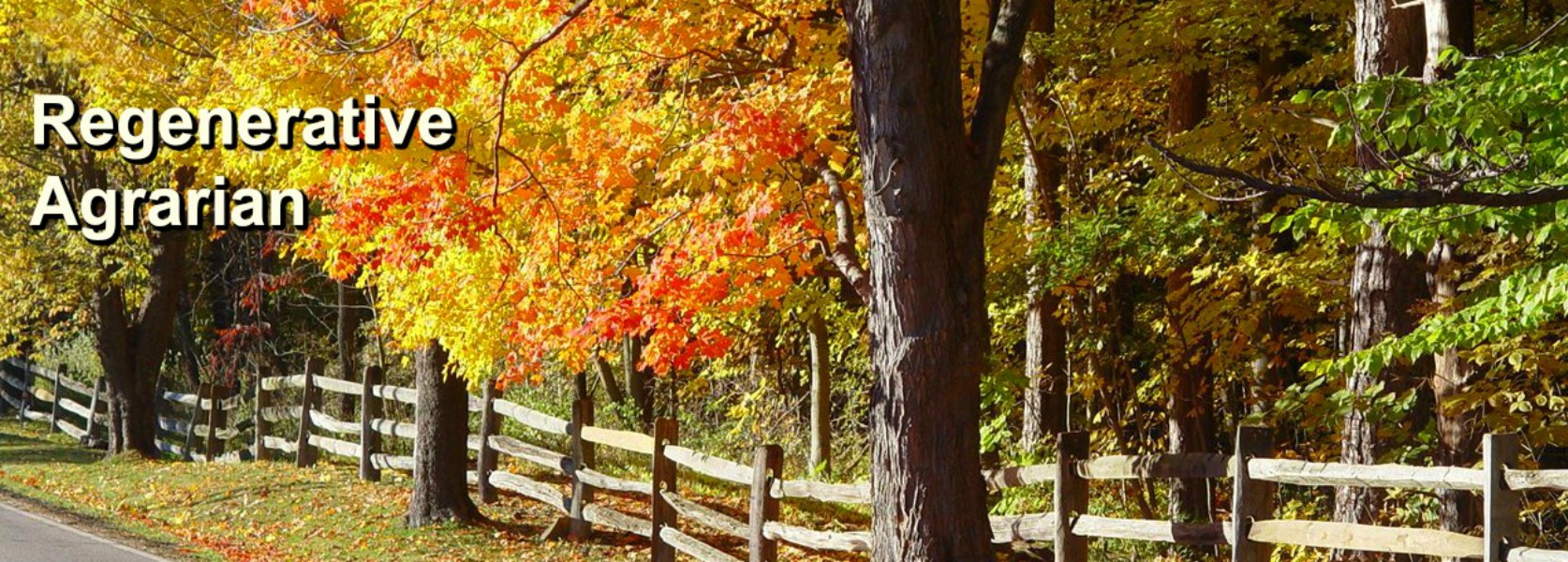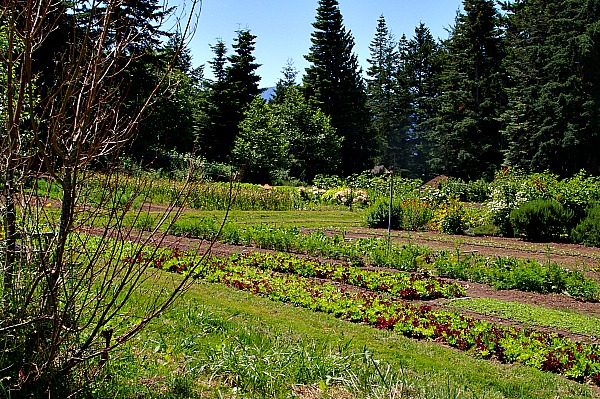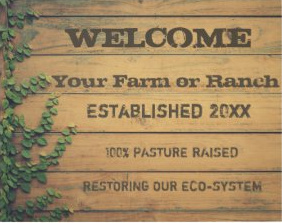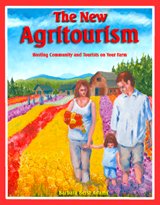Regenerative farming that teams up with the wild: How Wild Farm Alliance works with farms and ranches
© National Lilac Publishing, LLC First published by Barbara Berst Adams
in AcresUSA Magazine
Each time we plant borders for beneficial insects or erect perches for raptors as rodent control, we’re offering something to wild nature in exchange for it being our ally as we nurture domesticated crops. Sometimes, as with Nettles Farm on Lummi Island in Washington State, even wild nature’s own bounty makes its way into the farm’s offerings. Nettles is surrounded by the sea and natural woodlands. Wild rose petals, wild plums and even edible seaweeds can find their way into the foods of the chefs they supply at the famous Willows Inn.
Meanwhile, more and more information keeps surfacing on the huge potential agriculture has towards climate and natural resource restoration. But both farmers and wild nature are vulnerable, and like any good partnership, the union can truly sustain itself when each partner receives ongoing symbiotic support from the other -- each helping the other to continue to thrive. This article focuses on how eco-farmers are affected by growing desires and expectations to support eco-systems while earning a living at the same time, along with how I’ve seen an organization called Wild Farm Alliance assist them.
Even if it initially appears a future farm and wild nature partnership would be symbiotic eventually, the transition time to reach that state needs to be financially and labor-wise doable. Farms can’t support nature if they go out of business in their attempts to do so, so therefore sell out to development or corporate agriculture. And because consumer demand fuels the farm with its financial support and policy voting, consumer understanding of the process farms must go through to reach and maintain higher states of sustainable regeneration is also intrinsic to the partnership.
Wild Farm Alliance (WFA) seems aware of “the good partnership.” It works on many fronts towards a mutually beneficial relationship between organic farmers and wild nature, including assisting farmers with practical on-farm methods, and improving the USDA organic certification process to make sure it includes nature-supportive conservation practices. With a main office in Watsonville, CA, and a remote office in Minneapolis, MN, the Wild Farm Alliance was founded in 2000. Wild nature is the great demonstrator of the value of diversity, and the organization promotes the many benefits of biodiversity on farmlands. Its board members and panel of advisors also reflect diversity in that they work and reside in many locations across the country, and include current working farmers and ranchers, researchers, educators, and even the well-known restaurant owner, Alice Waters, who works with a network of sustainable farmers to support regenerative agriculture. WFA reports that 37% of the earth’s land is dedicated to agriculture, making farmland a top priority for earth regeneration and wildlife conservation. While they assist farmers, they also connect with them for the purpose of learning from them. And that’s valuable to farmers, because we have to be careful that non-farming certifiers and agricultural advisors do not become too distant from farming itself. Often, farmers themselves are the ones on the forefront of continual discovery and innovation by being constantly engaged in their operations.
Buzzing with words
Buzzwords and recognizable eco-labels can help generate the consumer support needed for ecological farming to thrive. With understandable definitions and consumer acceptance. Within eco-farming’s arena, the correct terminology gets debated and re-arranged like in any arena, but it seems to have sped up lately. We watched the word “natural” fall by the wayside long ago until a new certifying group arose to try to give it a positive meaning again (Certified Naturally Grown). And now the term “sustainable” is losing its shine with some. (See sidebar, “The Sea of Certifications,” to the right.) But WFA gives sustainable a definition, and believes the term sustainable agriculture means “biological conservation, as well as, the interconnection between nature, the community, and the farm.”
WFA also offers, among other publications, Biodiversity Conservation: An Organic Farmer's and Certifier's Guide which can be downloaded for free from their website. This guide helps describe the biodiversity conservation expectations already in existence within the USDA Organic label. Not all eco-farmers want or need USDA certification and it’s great there are other eco-choices that serve different purposes. Old labels can become watered down or lose meaning as we expand our understanding of regenerative ranching and carbon farming, GMO invasion, beyond humane animal treatment and the impact of lost pollinators and deteriorating water supply. But in some cases, already established labels may need to be clarified or updated instead of dismissed for new names that sound better, at least at first.
Groups like WFA and others can help with widespread understanding and agreement on terminology -- helping descriptive terms find balance between remaining dynamic as humans grow in knowledge, yet grounded in farmer and consumer acceptance and recognition.
Perhaps then the sideshow of continually replacing old terms with new ones can slow down to a workable speed, and consumers can steady themselves from the dizziness of terminology chaos, overlap and conflict. We do want fresh newness and plenty of choices. New labels or new names and updates for old labels can work, as long as too many choices too quickly don’t backfire and we don’t throw out the baby with the bathwater. Because effective updates mean communicating those changes to all whom they affect, even non-farmers. Non-farming consumers have their own occupations with jargon and labels and insider buzzwords to deal with. We need to meet consumers at least half way when helping them understand the depths of our own terms and labels to avoid becoming “eco-farm snobs” who take the true meaning of labels for granted while it serves to confuse or make consumers feel belittled for not knowing what we know from being on the forefront. WFA offers resources for this and helps educate consumers.
Practical farming methods
Some of the on-the-ground methods WFA researches,educates, and assists in include farm hedgerows, riparian restoration, watershed conservation, the infusion of native flora and fauna into the farmscape, and others.
With hedgerows, as just one example, WFA points out that when these native plantings outline agriculture fields creating habitat for native pollinators and pest predatory insects, it can ease the financial burden of purchasing pesticides. As well, multiple studies show the yields of many crops rise often substantially when the density and diversity of appropriate pollinators are present, further adding to farm income and helping keep the farm solvent. For wildlife, hedgerows can also create corridors that attach farmlands together and help wildlife safely move across landscapes.
Hidden Springs Ranch of California, owned by winemakers Steve and Pamela Storrs, was assisted by WFA, along with the Community Alliance with Family Farmers and the Wildlife Conservation Board. Organic and sustainably grown grapes are valuable on their own, and in addition, the owners allow 40% of their 58 acres to remain as a natural setting. They're involved in projects to further enhance natural habitat which include wildlife paths, native grasses and wildflowers as filter strips for water quality, providing for beneficial insects, and restoring the property’s oak woodlands that surround the vineyard.
WFA also assisted Hain Ranch Organics, a 31-acre organic walnut and poultry operation in California, in a three-year riparian restoration project. Riparian buffers can be highly effective in preventing river floods, while acting as natural water filtration systems and wildlife habitat. The ranch’s project mutually protected wild nature as well as the farm’s business, because previously, four acres of walnut trees had been lost to river floodplain. Also, native trees and shrubs that were planted attract pollinators, parasitic wasps, and other insects beneficial to the walnut orchard. Amidst various challenges, the farm and wildlife were suffering from drought. When drip irrigation was installed, thirsty rabbits chewed holes in the drip tape trying to get water. So stakes were used to raise the drip lines three feet above ground, and pans placed on the ground beneath some of the emitters to supplement water for wildlife.
Helping farmers find financial sources
Most farms are a segment of commerce and have to deal with fluctuating markets along with soil and crop care. They’re not steadily funded environmental charities with secure financial endowments or separate fundraising departments. Even when certifying programs or eco-farming organizations such as WFA don’t offer funds themselves during a farmer’s transition into more wild farming methods, they can help them find various sources of funding assistance elsewhere. WFA states that among its goals is promoting private and public conservation incentives that compensate farmers for their stewardship efforts.
The Wildlife Conservation Board, for instance, helped fund the improvements on Hidden Springs Ranch. And, students from an alternative high school helped with planting and mulching. With Hain Ranch Organics, the Wildlife Conservation Board supplied funding for their project. Further, volunteers from the Boy Scouts, Pinnacles National Park staff, and an environmental educational group called Naturalists at Large offered labor assistance.
Another farm the WFA has connected with and now showcases is Winter Green Farm in Oregon. The farmers allow a portion of their 170 acres to remain in native forest and riparian habitat. Along with many of their own wildlife enhancement practices, part of their wild farming efforts included eliminating invasive plants and widening the riparian corridor with both native and harvestable shrubs and trees. Their cattle, which are rotationally grazed, were then fenced away from it. There is now also a fish-friendly culvert which protects cutthroat habitat. Cost share funds for these projects was provided by The Natural Resources Conservation Service’s Environmental Quality Incentive Program.
Recruiting the non-farming population as a third ally
During a past Senate hearing, Lindsey Lusher Shute, executive director and co-founder of the National Young Farmers Coalition, stated, ““Farming is a career that’s easy to love, but to recruit the next generation of farmers, it must also provide a decent living.” Funding for one-time projects are helpful during transitions, and insurance, affordable land trusts, low-interest loans and various compensations can also be valuable. But as mentioned, farms are businesses, and it eventually comes down to producing food, fiber and fuel that consumers are willing to pay for in a manner that keeps farmers financially secure enough so that current experienced ones don’t sell out, and the future ones are attracted. There is much involved in this, and one segment is maintaining the support of non-farming citizens who buy the products and influence policy votes.
To maintain partnerships between non-farming citizens and farmers/wild nature, it can help to keep the idea of ideological extremes in mind, where we categorize others as either all evil or all omnipotent. Perhaps it’s simply human to scapegoat and blame groups and entities we don’t personally belong to for the state of affairs and put them in the evil category. And to then perpetually search for the invincible hero to take it all on as we, the mere victims, sit back, enjoy relatively little responsibility, and expect nothing but perfection from our heroes.
But while we want consumer support and respect for regenerative farmers when it comes to purchases and policy-making, we can also gain value from staying out of the polarizing game -- the either-or categorizing when farmers are presented as potentially huge game changers in planet restoration. They can be presented as making an impressive and even imperative impact, but still as being human with needs and vulnerabilities like all humans. Otherwise, we risk losing farmers to unrealistic demands by a population that doesn’t understand what they’re up against.
One method to help ensure against that is consumers themselves witnessing how complex and experimental the transition from conventional to environmentally supportive farming is, the challenges the farmers must solve, and the vast information they must hold and orchestrate. This can help protect farmers from unreasonable expectations, while generating more authentic consumer respect and support for what the farmers actually can do.
And this is yet another service WFA has assisted in. With the Hain Ranch Organics project described above, the first step of understanding the mutual benefits between farm and wild nature were achieved. Next, the funding and labor during the transition came in. But one more step, agritourism, took place which wove in the way for non-farming consumers to walk in the shoes of a farm in alliance with wild nature.
Once the plants were established on Hain Ranch Organics, WFA put on a daylong field tour to showcase the farm's biodiversity. “Farmers, students, conservationists and agricultural professionals who attended the field trip reported deepening their knowledge about specific plants that support pollinators and natural enemy insects, the challenges of irrigation systems and the benefits of incorporating nature on the farm,” Jo Ann Baumgartner, executive director of WFA, told me. At the gathering, the Xerces Society and the USDA Natural Resources Conservation Service also shared their knowledge.
Hain Ranch Organics continues to find other ways for non-farmers to understand. For example, Danielle Tsi, the writer and photographer for “Beyond the Plate,” an award-winning blog that explores food and where it comes from, was allowed to visit the farm and share photos and a write up of the processes that go on there.
Along with students, environmentalists and others who are already at least somewhat on board regarding restorative agriculture, even non-involved citizens who like the idea of spending an afternoon on a farm can greatly contribute to the supportive social structure by learning and observing the complex benefits of incorporating nature’s systems. One of the properties assisted by WFA, Hidden Springs Ranch, also described above, plans to share their methods of increasing biodiversity while maintaining crop productivity at the same time with a winery and tasting room open by appointment to the public. This will allow customers to directly witness the work put into their earth restoring wines.
The point being that humans don’t automatically value other people’s work, including farmers, “just because.”
But when they witness it or even experience it themselves, they’re more likely to value and appropriately support those who do that work with their purchases, their social support of farmers, and their voting. And when farmers can tell them directly what role rabbits play in balancing the eco-system, and when farm visitors witness how an irrigation system was destroyed by thirsty rabbits, so was reworked in a manner that continues to supplement the rabbits’ water, they come closer to understanding the challenges and risks a farmer takes.
While non-farmers may not have the need to memorize and retain the details of the farm experience for their own career or lifestyle goals, at the very least they come to realize in general “how much they didn’t know,” and that for reasons beyond their own educational expertise, they’re support becomes part of the solution, also, rather than sitting back and expecting absurd demands on regenerative farmers to be fulfilled.
This is not to pressure all farmers to bring non-farmers onto their property. There are liability concerns, children who drop cell phones they were supposed to leave at home into watering troughs, and farming time that must be budgeted. Plus, farmers can reach non-farmers via other ways like through their own farm websites or at farmers markets.
But when enough regenerative farmers who like the idea get involved in agritourism become involved in it, and enough of the population no longer polarises the farmer into either “dumb polluting farmer” or “unpaid environment and local food craze superhero,” it can filter out into the larger population for the benefit of all.
In a post on Civileats.com, “Quitting Season: Why Farmers Walk Away From Their Farms,” author Debbie Weingarten illustrates how even young enthusiastic ecological farmers have had to give up when markets didn’t support the true cost of their farmed products. The constant wear and tear on emotional and bodily energy that comes from barely eeking by for years on end eventually takes its toll. This, Weingarten describes so well when she says, “Behind the scenes, farmers spend hours at the computer, wearily adding up market totals and expenditures. It is here in this solitary lamplit space that farmers visit some very dark emotional places. It is impossible to convey the deep anxiety for everything at stake, the fear that accompanies the risk, and the wounds that this stress inflicts upon a psyche or a family.”.
Hopefully, enough of the non-farming population is willing and able to support this path when enough of them are given a chance to understand the far reaching value of the regenerative farming methods they support.
That way, regenerative farmers themselves, both current and aspiring, don’t become another endangered species. And non-farmers, too, aren’t endowed charities, even the ones who support the environment. So they, too, need to benefit by receiving a supportive return right away in the form of delicious, unique farmed products that introduce them to what they’ve been missing from industrialized, centralized, and corporate agriculture.
It was many years ago when I visited Nettles Farm on Lummi Island in Washington State. At one point, it almost had a near defeat with the farmer having to walk away. But along with its quick-thinking farmer and a popular chef who believed in local food, a non-farming community from the locals to the east coast did step up in time to support their efforts. Nettles Farm was able to continue and eventually be passed on as the organic farm it started out as from the original older farmer to younger ones. It continues to supply Willows Inn, and now also offers wild foraging workshops on the farm. Willows Inn has even been featured in a New York Times article entitled “10 Restaurants Worth a Plane Ride” (yeah, we know, plane rides aren't that regenerative... yet) and the owners have had an abundance of customers on their remote ferryboat-access island.
Humankind stepped out of the pure wilds about 12,000 years ago and embarked on agriculture. Eventually we got further and further from the rhythms of the wild to where ideas such as dominance, control, monocropping and even destruction defined agriculture. A growing number of people, although they don’t want to return unconsciously to the wild, do want to return in another way. Possibly somewhat like the way T.S. Eliot’s quote suggests, that “we will arrive back where we started, but know it for the first time.” By assisting in moving away from factory, centralized, chemically dependent and GMO farming and moving towards symbiotic farming with nature that empowers the nearby communities and farmers doing the work, organizations such as Wild Farm Alliance can be a helping hand towards that return.
__________
Short video from Wild Farm Alliance on the benefits to farmers of bird habitat.

The Sea of Certifications:
© National Lilac Publishing, LLC by Barbara Berst Adams
From grassroots movements to government agencies, many eco-friendly farming certification options are available today. They include Bee Better Certified, Salmon-Safe, Animal Welfare Approved, Climate Beneficial™, Certified Naturally Grown, USDA Organic, Certified Wildlife Habitat®, Non-GMO Project Verified and many others including the proposal of a new regenerative agriculture label that highlights carbon farming. Farmers can gain knowledge from certifying agents, and farms with certifications can attract customers and also help spread consumer awareness through seeing such labels on their products.
Even so, a single farm could be overwhelmed
(if not overrun) by pursuing every conceivable type of certification
that supports the welfare of the planet. Even if a farm’s compliance is
already mostly in place for one or more certifications, fees and time
spent on paperwork do add up.
To help narrow it down, consider the following questions:
- Which ones mean the most to your customers? The growing number of possible certifications can backfire and confuse consumers as words such as natural, sustainable, organic, regenerative and so forth go up and down in popularity and seem to change definition every so often, with new buzzwords arriving faster and faster. Which certifications would your specific customers relate to? If you never see your end customers and sell wholesale to distributors who only deal with USDA Organic certified products, the USDA certification is the obvious choice.
But if you have even a minimal online presence where end-customers might research your farm before purchasing your products in stores, perhaps there are other certifications that would appeal to them. If you know your products are distributed regionally, for example, perhaps customers would relate most to a regional certification near them like Certified Pollinator Habitat from Monarchs Across Georgia, or Salmon-Safe if you market to coastal communities. Or, would a certification for your specific crop be helpful? The SERF (Socially and Environmentally Responsible Farm) certification is for Christmas tree growers who protect biodiversity, waterways, fish and wildlife habitat, and improve their soils. Also, it stands for providing a safe environment for workers and for the farmers involving themselves in the local community to support its economy, its environment protection and environment education.
Conversely, if you sell mostly direct to your customers and they’re allowed to visit the farm, certain pollinator and salmon safe practices you already use can, if you choose, be shown directly to your customers through farm newsletters and farm visits without certification.
- Which ones mean the most to you? Making farms beyond humane for animals? Supporting wild pollinators? Carbon farming? Honeybee protection, for example, may especially be a passion for you, and certification connects you with others of like mind and contributes to the certification agency.
- Which ones are you already qualified for where you wouldn’t have to re-arrange your operation to receive certification? Redwood Hill Farm & Creamery of California now uses the Certified Humane Raised and Handled® label, which helps put their customers’ minds at ease regarding the issues of inhumane farm animal treatment. But before they had it, and looked into its requirements, they realized they were already in compliance, and had been for decades.
- Without adding more certifications, perhaps you can expand your customers’ understanding of the eco-benefits of whatever certification(s) you already have in place. If you use the National Organic Program label, for example, the Wild Farm Alliance works to make sure biodiversity conservation is part of this program. But not all customers are aware of that and might like to know you’re not simply avoiding chemicals on your farm by complying to this label, but are contributing to the regeneration of our natural resources in other ways. As mentioned in the main article to the left, Wild Farm Alliance offers a free PDF entitled Biodiversity Conservation: An Organic Farmer's and Certifier's Guide which clarifies and offers practical information on the USDA’s National Organic Program’s guidelines on natural resources and biodiversity conservation. It might be perused to help your farm customers understand how valuable you, their USDA Organic farmer, is to the eco-system. Access to the PDF can be found on the Wild Farm Alliance website.





